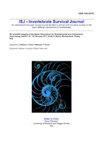Quantitative comparison for some immune responses among Eurygaster integriceps, Ephestia kuehniella and Zophobas morio against the entomopathogenic fungus Beuveria bassiana
IF 1.2
4区 农林科学
Q4 IMMUNOLOGY
引用次数: 9
Abstract
Some defense reactions including cuticular lipids, phagocytic activity, nodulation and hemolymph phenoloxidasec activity were compared in Eurygaster integriceps, Ephestia kuehniella and Zophobas morio exposed to five different B. bassiana isolates. The cuticular lipids were stimulating on conidia germination possibly with no fungicidal or fungistatic ability in epicuticular fatty acids. There was correlation between all studied immune system reactions and the virulence of isolates to E. kuehniella and E. integriceps. DE as a less virulent fungal isolate stimulated immune reactions in high levels in most experiments, despite of TV as the most virulent isolate. E. integriceps was the most sensitive host with lowered immune reactions. Z. morio showed resistant with the highest nodulation. E. kuehniella had moderate sensitivity with maximal phagocytic and the phenoloxidase activity. The phagocytic activity was the highest at 30 min after fungus injection. The nodulation and the phenoloxidase activity were demonstrated at 6, 12 and 24 h after injection. The most nodulation rate was observed at 24 h. The phenoloxidase activity for the most isolates reached a maximum value for Z. morio and E. integriceps after 12 h and in E. kuehniella after 24 h. Our research provides an interesting perspective in host susceptibility to fungal infections.整合巨噬菌、库氏Ephestia kuehniella和绦虫对球孢白僵菌部分免疫应答的定量比较
比较了五种不同球孢白僵菌分离株对整头巨噬菌、库氏Ephestia kuehniella和鼠蚤的表皮脂质、吞噬活性、结瘤和血淋巴酚氧化酶活性等防御反应的影响。表皮脂质对分生孢子萌发有刺激作用,可能对表皮脂肪酸没有杀菌或抑菌作用。所有研究的免疫系统反应都与分离株对库氏杆菌和整型大肠杆菌的毒力有关。在大多数实验中,DE作为一种毒性较小的真菌分离物刺激了高水平的免疫反应,尽管TV是毒性最大的分离物。大肠杆菌是最敏感的宿主,免疫反应较低。morio表现出抗性,结瘤率最高。库氏杆菌具有中等敏感性,具有最大的吞噬和酚氧化酶活性。注射真菌后30min的吞噬活性最高。注射后6、12、24 h,观察其结瘤率和酚氧化酶活性。大多数菌株的酚氧化酶活性在12 h后达到最大值,而在24 h后达到最大值。我们的研究为宿主对真菌感染的敏感性提供了一个有趣的视角。
本文章由计算机程序翻译,如有差异,请以英文原文为准。
求助全文
约1分钟内获得全文
求助全文
来源期刊

ISJ-Invertebrate Survival Journal
IMMUNOLOGY-ZOOLOGY
CiteScore
2.10
自引率
0.00%
发文量
0
审稿时长
>12 weeks
期刊介绍:
Invertebrate Survival Journal (ISJ) is an international and open access journal devoted to prompt and innovative studies on the basic defense mechanisms in invertebrates, in particular with a view to identifying biotechnologies able to act against derived diseases and related economic damage.
Contributions will be mainly in the form of Letters to the Editor, Visions and Perspectives, Short Communications, Technical Reports, Research Reports, Review, Minireview and Reports of Meetings. Letters to the Editor can be commentaries or perspectives on invertebrate defence mechanisms or replies to the data published in ISJ.
 求助内容:
求助内容: 应助结果提醒方式:
应助结果提醒方式:


